All, except one of the works in the exhibition, a portrait of the Uruguayan artist Joaquín Torres García, are imaginary portraits made by Flouquet during the years spanning from 1929 to 1931. They have never been shown before, since they went from the studio of their creator, who died in 1967, to his younger son André, then to the Belgian art historian Serge Goyens de Heusch, and finally to the collector Roberto Polo. The exhibition has been organized in collaboration with the City Council of Cuenca and will remain open until the end of December.
This exhibition is the first in a series that will showcase works from the private collection of Roberto Polo, cultural patron of Cuban origin, with the purpose of making the artist represented in CORPO better known. The Franco-Belgian artist Pierre-Louis Flouquet, one of the pioneers of the avant-garde movement in Europe during the first three decades of the twentieth century, is very well-represented in the Polo collection with a score of abstract and surrealistic works created through different techniques, including three surrealistic portraits. In addition, Roberto Polo has over 700 unpublished works on paper (many imaginary portraits) that, along with the three that are exhibited in Toledo, provide us with an insight into the artist’s vision of that genre and the role it played in his evolution. Flouquet was one of the most significant artists of the legendary Galerie Der Sturm, founded in Berlin in 1912, and the designer of numerous covers for the magazine that bore the name of that space, where the works of Marthe Donas, Victor Servranckx, Oskar Kokoschka, Edmund Kesting, Franz Marc, Vasily Kandinsky and many others were also exhibited.









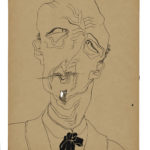
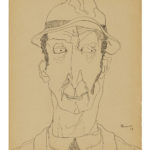
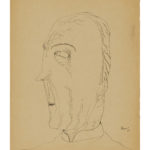
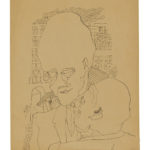


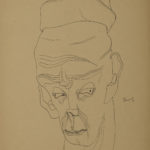


Between 1927 and 1931, he produced a large quantity of drawings in Indian ink with surprising virtuosity, representing phantasmagorical, hallucinatory faces, almost nightmarish, beyond any naturalistic inspiration. One could argue that they were part of a character-study collection, following the tradition enjoyed by artists like Leonardo da Vinci or flamenco mannerists, all with their love of caricature; Flouquet’s drawings possess an expressionistic nature that evidently border on caricature. The artist, anticipating in his works the facial defects that the Nazis would later directly reject for what they consider to be racial impurities, created his series of portraits at the same time as the ones that were drawn in Germany in the 1920s by creators such as Otto Dix, George Grosz and Max Beckmann. Flouquet inscribed himself in the history of the serial imaginary portrait drawn with spontaneous strokes initiated by Jean-Honoré Fragonard in France in the 18th century. Pablo Picasso also used this serial and gestural portrait genre in the second half of the 20th century.
After 1927, Flouquet seldom painted in oil, whereas India ink drawings
and gouaches on paper were for him a natural, almost daily form of expression, partly because of his new journalistic work after his return to Paris. These works on paper also include portraits of many artists, writers and musicians. Meanwhile, he continued to progressively cultivate the imaginary portrait genre, between expressionistic density and psychological study, with a gallery of grimaces, deformations, vices and miseries, of which an illustrative sample is displayed here. With the rise of the National Socialist German Workers’ Party, whose ideology was based on Nazism, Flouquet was branded as a degenerate artist, along with an endless number of more radical avant-garde creators, which lead the painter to quit art forever and dedicate himself to writing and book editing.
Biography of the Artist
Pierre-Louis Flouquet was born in Paris in 1900 and died in Bilbeek in 1967. In 1910, his family moved to Brussels, where he studied with Constant Montald and Gisbert Combaz at the city’s Royal Academy of Fine Arts. He interacted with the avant-garde of Antwerp, Berlin, Brussels, Lausanne, and Paris; he shared a studio with Magritte in Brussels. In 1921, he participated in the International Exhibition of Modern Art of Geneva and in the Centre d’Art of Brussels with Magritte. He was the cofounder of the avant-garde group 7 Arts, oversaw the painting section of its magazine, and was its illustrator.
With Eisenstein, Ernst, Gropius, Schlemmer, and Servranckx, among others, Flouquet was a regular guest at the Maison des Artistes of Baroness Hélène de Mandrot in her Château de La Sarraz near Lausanne, where the first International Congress of Modern Architecture, the first Independent Film Congress and many other revolutionary artistic events of the beginning of the century took place. Hélène de Mandrot, like Katherine Dreier and Gertrude Stein, is one of the pillars of modern art.
In 1925, Flouquet founded the L’Assaut group with Gailliard and organised exhibitions under his aegis. Having become the leader of La Plastique Pure, he regularly held exhibitions abroad: Buenos Aires, Chicago, Leipzig, Madrid, Monza, New York, Paris, Philadelphia and Zurich; and solo at the Der Sturm Gallery (1925) and the Deutsche Werkbund in Stuttgart (1927), invited by its founder, Henry van de Velde. Flouquet also designed many covers for the revolutionary art magazine Der Strum.
He died in 1967. His works are displayed in many museums, such as the Royal Museums of Fine Arts of Brussels and Antwerp, as well as in the Museum of Fine Arts of Gent, and the avant-garde Musée de Grenoble. Major exhibitions featuring his work were held in the museums De Lakenhal of Leiden and Gent, as well as at the Tate Modern in London, among others.




